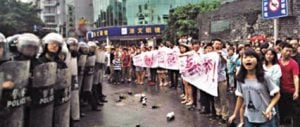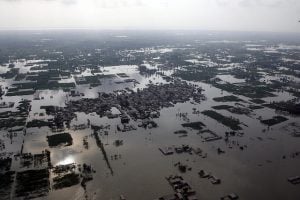January
The year got off to a bang – literally. The customary fireworks set off for Chinese New Year (around 600 million yuan’s worth in Beijing alone) triggered a dangerous spike in levels of fine particulates (PM2.5), a pollutant linked to asthma and lung cancer. As a debate about the environmental hazards of China’s explosive festivities got under way, however, there was a glimmer of good news: the spike was reflected in an air-pollution index just launched by Beijing’s authorities, giving credence to government promises to improve public air quality data in 2012. Air pollution remained a hot topic throughout the year – even prompting a PM2.5-themed rock concert in Beijing.
February
Conservationists welcomed an announcement from upmarket Shangri-La hotels that the chain would no longer serve shark fin at any of its hotels and resorts and planned to phase out Bluefin tuna and Chilean sea bass during 2012. The news followed long-running campaigns to raise awareness about the impacts of overfishing and eating endangered species in China. Momentum appears to be picking up: a proposal to ban shark fin from government banquets also featured among the green proposals put forward during China’s annual parliamentary session in early March.
March
A coalition of Chinese NGOs conducted an investigation into whitening cosmetic products, finding 23% of samples contained hazardous levels of mercury. It wasn’t the only incident to fray public nerves over the safety of everyday products this year: in April, CCTV revealed a factory in Hebei province had been selling gelatine made from leather scraps for use in medicine capsules. And in May, a student’s database of food-safety scandals crashed after getting 25,000 hits in two hours. While public despair over China’s food safety crisis grew, Chinese official Wang Guowei shrugged off the panic in an interview with chinadialogue, saying the Chinese people had a “poor understanding” of the issues.
Also see: chinadialogue’s special report “Food safety in China”
April
State media reported that another 100,000 people may have to be moved from the Three Gorges Dam area over the next three to five years due to heightened risk of landslides. News of the probable relocations – coming after 1.2 million people were already moved to make way for the US$30 billion structure – bolstered concern about the links between mega dams and geological disasters. A report from campaign group Probe International, which looked at 130 dam sites in western China, claimed 48.2% lay in zones of high to very high seismic hazard, adding fuel to the fire.
May
May 17 saw China’s first auction of drilling rights for shale gas exploration as the country seeks to replicate US success in the unconventional gas market. Though many argue China’s potentially vast reserves of shale gas could help wean it off carbon-intensive coal, the development had a mixed reception. Environmentalists urged caution, pointing to the large quantities of water needed for drilling in water-scarce regions of China and tales of America’s poorly regulated fracking boom. The government is aiming for 6.5 billion cubic metres of shale-gas production per year by 2015.
June
A move to launch boating tours on one of Tibet’s sacred lakes sparked a public outcry and eventually suspension of the project. Opponents argued that Yamdrok Lake, where monks come to pray when “Living Buddhas” such as the Dalai Lama die, would be turned into a “money-making playground for local government and tourism companies”. Tourism is now firmly on the list of perceived threats to the fragile Qinghai-Tibet plateau, along with dam construction, wildlife poaching and grassland degradation.
July
The events of July confirmed 2012 as China’s year of environmental protests and shone a light on the struggle of officials to respond to the growth of civil unrest. Mass demonstrations broke out first against construction of a copper factory in Shifang, Sichuan province, and later over a planned pipeline to take wastewater

from a Japanese-owned paper plant to the sea in Qidong, Jiangsu. The autumn saw another huge protest, in Ningbo city, this time against expansion of a paraxylene (PX) plant. In each case, the offending project was cancelled.
July was also a tragic month for Beijing, where at least 37 people died after the heaviest rains in at least 60 years saw flash flooding, causing hand-wringing over the capacity of the capital to deal with extreme weather. Flooding official Cheng Xiaotao told chinadialogue the city had focused too heavily on disaster response rather than prevention.
August
China published its 12th Five-Year Plan for renewable energy in August, with a particular emphasis on hydropower, wind, solar and biomass. Targets include 290 gigawatts of installed hydropower capacity, 100 gigawatts of wind and 21 gigawatts of solar by 2015, as part of a government commitment to source 9.5% of total energy from clean sources by the same year. Emission-cutting ambitions were also reflected in the environment ministry’s announcement that cars would be subject to tougher exhaust standards as of next year. It’s worth noting, however, that previous attempts to improve car fuel standards have hit stumbling blocks in China.
September
President Obama blocked Chinese company Ralls Corp from buying four wind farms near a US navy base in Oregon, citing national security concerns. His tough stance was interpreted by many as a play to voters’ anti-China sentiment in the run-up to the presidential elections. But it’s also symptomatic of an increasingly hostile global clean-tech market. The US this year announced plans to impose 15% tariffs on solar imports from China to offset subsidies it blames for flooding the market with cheap PV panels. EU regulators have made similar accusations, and are meanwhile locked in a dispute with China over plans to include airlines in their cap-and-trade scheme.
October
Global clothing brands including Armani, Calvin Klein and Zara, were linked to devastating water pollution in China in an investigation into the Chinese textile industry. A coalition of Chinese NGOs, led by the Institute of Public and Environmental Affairs, identified 49 top brands it said were using polluting factories to manufacture their clothing lines.
 November
November
All eyes turned to China in November as the country’s next generation of leaders was formally unveiled at the 18th National Party Congress. Party chiefs placed renewed emphasis on the environment at the once-in-five-year event, with outgoing president Hu Jintao reiterating his call for construction of an “ecological civilisation”.
Also see: Eight major challenges for China’s new leaders
chinadialogue also held its first ever live, online discussion, bringing together energy experts from both China and the US, plus members of the public, to discuss climate policy and the relationship between the two superpowers. Read the full transcript of the discussion.
December
The final month of the year saw the conviction of Chinese environmentalist Liu Futang for “illegal business activities” in a court in Hainan, south China. Liu, winner of the citizen journalist category in chinadialogue’s 2012 environmental press awards, was accused of profiting illegally from self-published books about environmental destruction on Hainan island, despite the fact he gave most of his books away for free. He was given a three-year suspended prison sentence and fined 17,000 yuan. Coming just weeks after the Chinese government’s high-profile advocacy of an ecological civilisation, the verdict left many questioning the authorities’ commitment to environmental protection.




